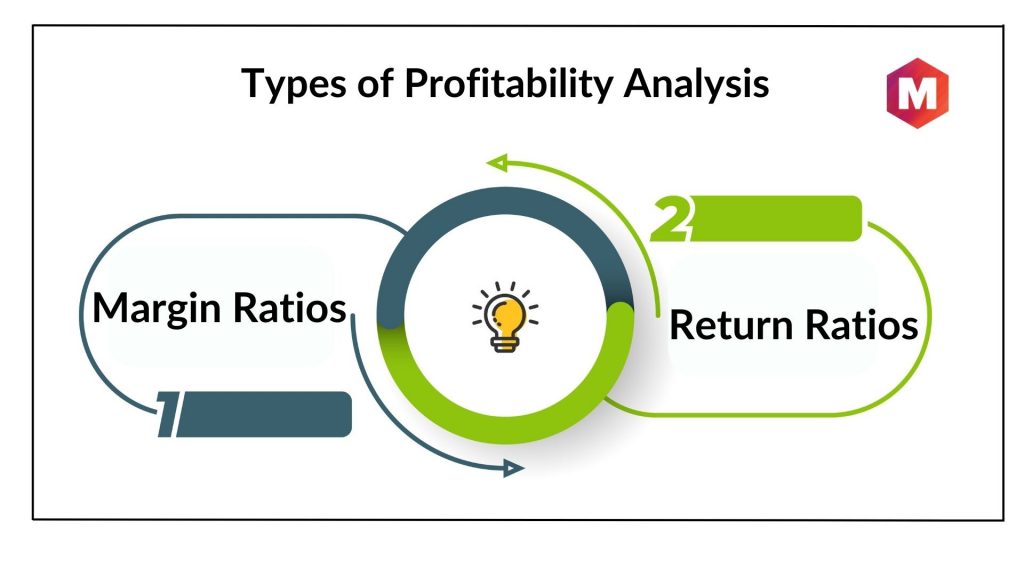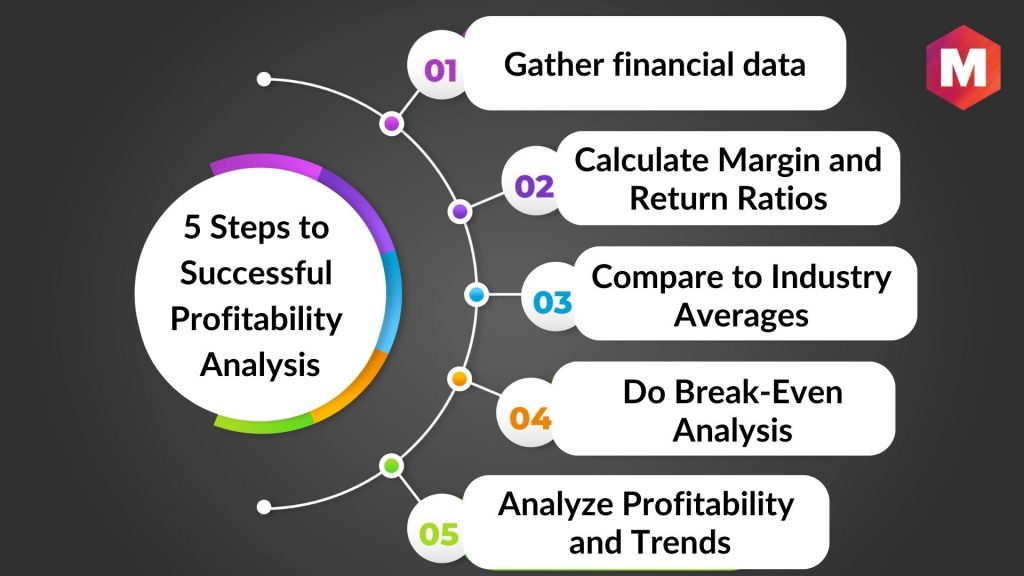Definition: The profitability analysis is a financial analysis method that calculates how much profit a company generates in comparison to the total revenue earned. It refers to the gains or profits a business earns compared to the amount it spends. This is used to evaluate how efficient the business is in its operations.
A good example of profitability analysis is the calculation of gross profit margin. This is the difference between the total revenue earned and the cost of goods sold. It measures how much money a business has left after all expenses are accounted for.
The profitability analysis can also be used to identify areas where the business can improve its performance. For example, if the analysis reveals that some costs are higher than they need to be, the business can then take steps to reduce those costs and improve its profitability.
Keeping tabs on your business’ performance is crucial, and one of the best ways to do that is by conducting a profitability analysis. This involves subtracting all overhead costs from capital to determine how much money remains in profit. With this information at hand, businesses can better optimize their profits and reach maximum success!
Table of Contents
What is Profitability Analysis?
Profitability analysis is the process of using financial metrics like margin ratios and revenue ratios to evaluate a company’s ability to generate profit. It involves examining both operating expenses and sales revenue to determine how efficiently a company is generating profits. By calculating and comparing profitability ratios from multiple periods, companies can track the progress of their profitability over time.
Enterprise Resource Planning (ERP) utilizes profitability analysis to streamline and automate daily business operations. As a component of ERP, it assists in assessing the profits generated from various business segments and creating reports that include the company’s current profitability status. Profitability analysis is an important tool for gaining insight into a company’s financial health and helping to make sound decisions.
Why Profitability Analysis is Used?
You can conduct profitability analysis to –
1. Track Performance and Record Progress
Profitability analysis helps businesses keep track of their performance. By tracking the company’s profits and margin ratio, companies can measure how well they are doing in comparison to past performances, or to similar businesses in similar industries. Profitability analysis also allows businesses to identify trends in their performance so that they can adjust their strategy accordingly.
2. Identify Optimal Product Mixes
Profitability analysis helps companies to determine which products are generating the highest profits. By comparing a company’s fixed and variable expenses, they can identify the most profitable product mix and work to improve the profitability of their current offerings. Companies can also use profitability analysis to spot unprofitable product mixes that should be discontinued or modified.
3. Maximize The Use Of Assets
Profitability analysis helps businesses to maximize the use of their assets. By examining their return on equity (ROE), companies can identify which investments are generating the highest returns and allocate capital toward those areas of the business that offer greater potential for growth and financial gains.
4. Understand Return On Equity
Profitability analysis also helps businesses to understand their return on equity (ROE). ROE measures the number of profits generated per dollar invested in the business and can reveal if a company is using its assets efficiently or inefficiently. Companies can use this information to reassess how they are allocating their resources and make adjustments to improve their ROE.
5. Examine Vendor And Customer Relationships
Profitability analysis can also help businesses to examine their relationships with vendors and customers. By understanding which vendors are providing the most profitable products and which customers are generating the most sales, companies can work to strengthen these relationships and improve their profitability.
Types of Profitability Analysis
Profitability analysis types can be categorized into two types of ratio analysis- Margin Ratios and Return Ratios. Let’s go through them now –
Margin Ratios
Various profit margins such as gross margin, operating margin, and net profit margin are used to measure a company’s profitability at different stages of analysis. When costs are low, the profit margins increase, but they decrease as additional costs such as COGS, operating expenses, and taxes add up.
Let’s understand this with an example – a company with a sales revenue of $1,000 and operating expenses of $500 will have a gross margin of 50%. This means that the company is generating 50% of its sales revenue as gross profit. Some of the types of margin ratios are-
-
Gross Profit Margin
Gross profit margin is used to measure the profitability of a business in terms of its sales. It looks at the difference between how much it costs to produce a product and the gross revenue that item generates. Gross profit margin can be a great way to see which products are most profitable and make adjustments accordingly.
Formula – Gross Profit Margin = Gross Profit/Sales
-
Net Profit Margin
Net Profit Margin is similar to Gross Profits Margin but looks at the company’s overall net profits. It measures how much of each dollar in sales remains after subtracting all costs and expenses. Knowing this metric helps business owners determine if they are operating efficiently and gives them an idea of their overall profitability.
Formula – Net Profit Margin = Net Income/Sales
-
Operating profit margin or EBIT Margin
Operating Profit Margin looks at a business’s operating income after all expenses have been taken into account. This metric is important for understanding the profitability of everyday operations and can be used to make adjustments to improve efficiency.
Formula – Operating Profit Margin = Earnings Before Interest and Taxes (EBIT)/Sales
-
Cash Flow Margin
The cash flow margin is a measure of how effectively a business can turn sales into cash flow. In other words, it shows how much cash or income your business can generate from your operating activities. A higher margin suggests that the company can pay its vendors or suppliers and invest in capital assets.
Formula – Cash Flow Margin = Cash Flow from Operating Activities/Net Sales
Return Ratios
Return ratios are used to analyze a company’s ability to generate income and create wealth for its shareholders. By comparing investments in assets or equity to net income, these profitability ratios can indicate how well a company manages its investments.
For example, a company ABC might have a return on assets of 10%, which would mean that the company has generated $10 in income for every $100 invested in its assets. Some of the types of return ratios are –
-
Return on Assets
It refers to the profit a company makes from its total assets. This ratio compares the company’s net income to the capital invested in the assets. By calculating the return on assets, it is possible to determine how effectively the company is utilizing its economic resources.
Formula – The Return on Assets = Net Income/Total Assets
-
Returns on Equity
Returns on Equity (ROE) is a profitability measure that looks at how well management is utilizing the company’s assets to generate returns. Profitability analyses should also take into account ROE as it offers insight into how efficiently equity is being used and if there are opportunities for improvement.
Formula – The Return on Equity = Net Income/Shareholder’s Equity
Return on Invested Capital (ROIC)
The return ratio measures how effectively a company utilizes its capital from various sources, such as shareholders and bondholders, to earn returns for them. This metric is more intricate than ROE as it encompasses more than just shareholder equity.
It measures after-tax operating profit against the total amount invested in a company, including both debt and equity. It helps companies evaluate how they are using their capital effectively. Additionally, investors use ROIC to determine the value of a company. If a company’s ROIC is higher than its WACC, it may mean that the company is creating value and may have a higher stock price.
Formula – Net Operating Profit after Tax/Invested Capital
What Techniques you can use during Profitability Analysis?
Break-Even Analysis
A break-even analysis is an important tool for understanding the point at which a business’s revenues equal its costs. This helps businesses determine how much revenue they need to generate to stay in the black. Businesses can use this information to adjust prices or expenses to maximize profits. So if the net profit or gain is zero, it indicates the break-even point. Additionally, using break-even analysis is a useful approach to analyze profitability since it lets you determine the minimum revenue required to maintain your business.
Benchmarking Industry Profitability Ratios
Businesses should also compare their profitability ratios to those of the industry. Benchmarking against industry averages will help business owners understand how well they are performing relative to their competition. The more familiar you are with the industry averages, the better your chances of making informed decisions that will improve overall profitability.
5 Steps to Successful Profitability Analysis
1. Gather financial data
The first step to profitable analysis is collecting all the necessary financial information and analyzing it for trends. This includes looking at income statements, balance sheets, cash flow statements, and other financial documents.
2. Calculate Margin and Return Ratios
Once all the financial information is collected, margin and return ratios can be calculated to measure profitability. This includes calculating net profit margin, operating profit margin, cash flow margin, return on assets, return on equity and return on invested capital.
3. Compare to Industry Averages
After calculating the various profitability metrics, compare them to industry averages. This will give you an idea of how your business’s performance stacks up against competitors in the market.
4. Do Break-Even Analysis
Break-even analysis helps to determine the minimum amount of sales that must be generated to cover all operating expenses. It’s a great tool for understanding how much sales revenue is necessary to make the business profitable. You can use this formula to calculate the break-even cost –
Break-even cost = Fixed Costs/Contribution Margin Ratio.
5. Analyze Profitability and Trends
The final step is to analyze the overall profitability of the business and identify any trends. This helps you understand the strengths and weaknesses of your business and how you can improve it in the future.
Example of Profitability Analysis
Consider a retail store that has been in business for the last 4 years. The store has seen its sales revenues go up by 25% but its operating expenses have increased by 30% in the same period. The management team can use profitability analysis to understand how its current revenues measure against its costs and whether it is achieving a good return on invested capital (ROIC). By analyzing the profitability of the business, they will be able to determine if there are areas where they can reduce their expenses or increase sales revenue. This will help them make better decisions about how to optimize their operations and maximize their profits.
Conclusion!
Profitability analysis is an important tool to use to measure a company’s performance. It can help identify areas of improvement and generate income by optimizing fixed and variable costs.
By understanding the cash flow margin, net income, and financial statements, business owners can gain insight into their profitability analysis and make informed decisions to improve the company’s performance.
Ultimately, a well-executed profitability analysis provides valuable information that can be used to identify areas of improvement, increase revenue, and maximize profits. When used correctly, profitability analysis can be a powerful asset for business owners, allowing them to make informed decisions that will ultimately boost their profits.
FAQs:
What Are the Most Important Profitability Ratios?
The most important profitability ratios for a business are typically gross margin, operating margin, and net profit margin.
What is the difference between profitability ratio analysis and customer profitability analysis?
Profitability ratio analysis looks at the overall efficiency of a business by comparing sales revenue to its operating expenses. Customer profitability analysis, on the other hand, focuses on understanding the profits each customer brings to the business.
What are the advantages and disadvantages of doing a profitability analysis?
The main advantage of conducting a profitability analysis is that it helps identify areas of improvement in terms of efficiency and cost savings. It also helps businesses understand their strengths and weaknesses compared to competitors. Despite its benefits, using this tool also has drawbacks. For example, it can be time-consuming to collect accurate data, and it does not predict future outcomes. Additionally, the results it produces may quickly become outdated.
Liked this post? Check out the complete series on Marketing



I am currently in grade 12 and I am busy with a task on the analysis of profitability.I have used 4 ratios pertaining to profit.I would like to know what else I should include in the analysis?
Help would be appreciated. Thanks